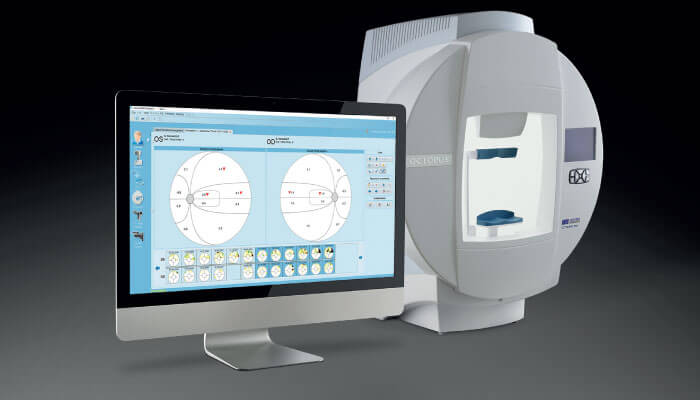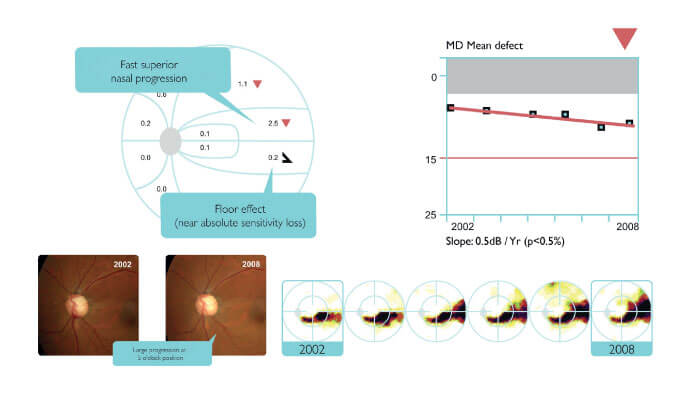
Glaucomatous visual losses typically appear as “clusters” of adjacent defects corresponding to pathways of affected retinal nerve fiber layer (RNFL) bundles. To better reflect this observation – and thus improve the sensitivity of glaucoma progression monitoring – Haag-Streit developed its Cluster Analysis system, which is based on the distribution of nerve fibers in the retina (1).
Cluster Analysis works by grouping together visual field test locations innervated by adjacent RNFL bundles (2) – and, as the names suggests, analyzes them in those clusters. Each cluster contains at least four visual field test locations; by measuring visual losses per cluster and calculating the mean cluster defect – Cluster MD – the system is able to identify even very low-level visual deterioration. The high sensitivity is derived from an averaging procedure that cancels out variations associated with measurements from single locations within the cluster. The result? Cluster Analysis is more sensitive to glaucomatous change than systems based on point measurements.
The process sounds complex, but interpretation of the system output is simple: Cluster MDs that are similar to the norm (p>5 percent) are marked with a ‘+’ symbol, while values that differ significantly from the expected range are marked in orange (p<5 percent) or red (p< 1 percent). The system also provides a visual representation, with cluster fields shaded light to dark according the degree of difference from the norm.
To assess disease progression, physicians employ the Cluster Trend Analysis capability, which – by methods similar to those used in Cluster Analysis – compares cluster values over time. Worsening at p <5 percent and p <1 percent is indicated with, respectively, open and solid red arrows, and the rate of change (dB/year) is indicated by a numerical value. This technique has been shown to be more sensitive than MD Trend Analysis and 24 Technology to Empower Sponsored Sect ion 25 local event analysis. As Jonathan Myers, Co-Director of Wills Eye Glaucoma Service in Philadelphia, US, commented: “This type of progression software saves the clinician a lot of time and helps them pick up subtleties they might miss (3).”
With Cluster Analysis, we can pick up tiny defects without needing to identify and count individual abnormal sites; and with Cluster Trend Analysis, we can quickly and objectively identify the extent of progression.
In short, these two innovations enable faster, more precise and less subjective glaucoma assessment.
Case study: visual field series in a patient with primary open-angle glaucoma
In Figure 2, we can see that MD analysis confirms slow progression (0.5 dB/year), but provides little information regarding the location of the change. Conversely, grayscale representations reveal a superonasal expansion; this approach, however, is not ideal for quantifying the speed of progression. Cluster Trend Analysis, by contrast, provides the clinician with objective information regarding both the location of defects and the speed of their progression. In Figure 2, we see how the system illustrates defects in the superonasal and superior clusters, and quantifies their progression (2.5 dB/year and 1.1 dB/year respectively). Statistically significant (p<1 percent) change is indicated with a red downward arrow; near absolute sensitivity loss is indicated with a black symbol (inferonasal cluster). Fundus images show rim thinning and RNFL loss spreading from the 1 - 2 o’clock position towards the 6 o’clock position. This correlation between fundus and visual field changes confirms glaucomatous progression.

References
- MJ Hogan et al., “Histology of the human eye: an atlas and textbook”, Philadelphia: WB Saunders (1971).
- L Racette et al., “Visual Field Digest: a guide to perimetry and the Octopus perimeter”, Köniz: Haag-Streit (2018)
- https://bit.ly/2DJcWUG
